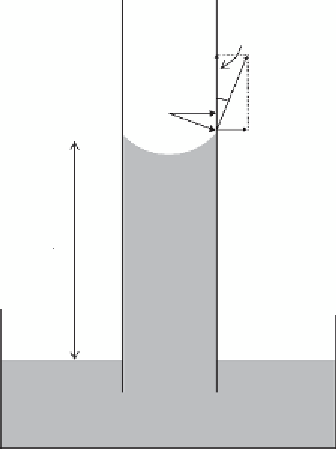Geoscience Reference
In-Depth Information
σ
cos
ϕ
ϕ
σ
r
R
z
c
Figure 4.7
Capillary rise of water in a glass tube.
face water tension
σ
(N m
-1
). In combination with the adhesive forces (expressed in
a so-called wetting angle
φ
),
σ
determines the maximum height. At equilibrium, the
vertical component of the surface water tension is equal to the gravitational force of
the lifted water column in the glass tube:
2
πσ ϕπ ρ
2
r
cos =
r
zg
(4.6)
c
were
r
is the radius of the tube (m),
ρ
is the water density (kg m
-3
) and
g
is the gravi-
tational acceleration (m s
-2
). This gives for the maximum height
z
c
:
c
=
2
σϕ
ρ
cos
z
(4.7)
gr
A general igure for surface water tension
σ
is 0.07 N m
-1
. In case of clean glass,
adhesion is maximum and the wetting angle
φ
= 0º (cos
φ
= 1). In case of clean steel,
no adhesion occurs and the wetting angle
φ
= 90º (cos
φ
= 0). Some materials and
soils repel water and are called hydrophobic. At these materials wetting angle
φ
> 90º
and cos
φ
< 0.
Question 4.5:
How much is the capillary rise (mm) of water in a clean glass tube with
a radius of 1 mm? And how much for a tube with radius 0.1 mm? Take
σ
= 0.07 N m
-1
and
g
= 9.81 m s
-2
.

Search WWH ::

Custom Search